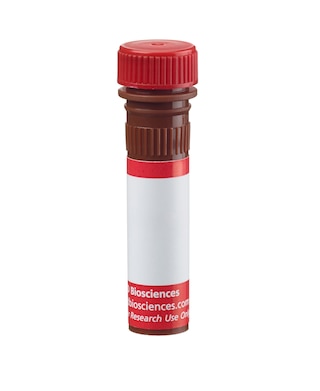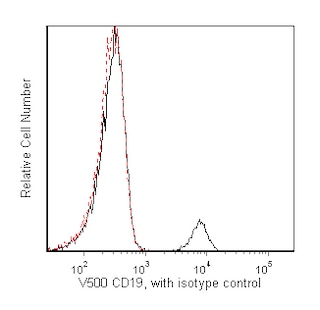-
Your selected country is
Middle East / Africa
- Change country/language
Old Browser
This page has been recently translated and is available in French now.
Looks like you're visiting us from {countryName}.
Would you like to stay on the current country site or be switched to your country?




Two-color flow cytometric analysis of FCRL5/FCRL3 (CD307e/c) expression on human peripheral blood lymphocytes. Whole blood was stained with BD Horizon™ V500 Mouse Anti-Human CD19 antibody (Cat. No. 561121) and either Alexa Fluor® 647 Mouse IgG2b, κ Isotype Control (Cat. No.558713; Left Panel) or Alexa Fluor® 647 Mouse Anti-Human FCLR5/FCLR3 (CD307e/c) antibody (Cat. No. 564343; Right Panel). The erythrocytes were lysed with BD Pharm Lyse™ Lysing Buffer (Cat. No. 555899). Two-color flow cytometric contour plots showing the correlated expression of CD19 versus FCLR5/FCLR3 (CD307e/c) (or Ig Isotype control staining) derived from gated events with the forward and side light-scatter characteristics of viable lymphocytes. Flow cytometric analysis was performed using a BD LSRFortessa™ Cell Analyzer System.


BD Pharmingen™ Alexa Fluor® 647 Mouse Anti-Human FCRL5/FCRL3 (CD307e/c)

Regulatory Status Legend
Any use of products other than the permitted use without the express written authorization of Becton, Dickinson and Company is strictly prohibited.
Preparation And Storage
Product Notices
- This reagent has been pre-diluted for use at the recommended Volume per Test. We typically use 1 × 10^6 cells in a 100-µl experimental sample (a test).
- Please refer to www.bdbiosciences.com/us/s/resources for technical protocols.
- Source of all serum proteins is from USDA inspected abattoirs located in the United States.
- The Alexa Fluor®, Pacific Blue™, and Cascade Blue® dye antibody conjugates in this product are sold under license from Molecular Probes, Inc. for research use only, excluding use in combination with microarrays, or as analyte specific reagents. The Alexa Fluor® dyes (except for Alexa Fluor® 430), Pacific Blue™ dye, and Cascade Blue® dye are covered by pending and issued patents.
- Alexa Fluor® is a registered trademark of Molecular Probes, Inc., Eugene, OR.
- Alexa Fluor® 647 fluorochrome emission is collected at the same instrument settings as for allophycocyanin (APC).
- Caution: Sodium azide yields highly toxic hydrazoic acid under acidic conditions. Dilute azide compounds in running water before discarding to avoid accumulation of potentially explosive deposits in plumbing.
- For fluorochrome spectra and suitable instrument settings, please refer to our Multicolor Flow Cytometry web page at www.bdbiosciences.com/colors.
- An isotype control should be used at the same concentration as the antibody of interest.
Companion Products





The 307307 monoclonal antibody specifically binds to Fc receptor-like 5 (FCLR5) and crossreacts with Fc receptor-like 3 (FCLR3). These type I transmembrane glycoproteins have sequences that are homologous to classical Fcγ receptors. FCLR5 is also known as CD307e, FCRH5 (Fc receptor homolog 5) and IRTA2 (immunoglobulin superfamily receptor translocation associated 2) whereas FCLR3 is referred to as CD307c, FCRH3 (Fc Receptor Homolog 3) and IRTA3 (immunoglobulin superfamily receptor translocation associated 3). FCRL5 and FCRL3 are differentially expressed by mature B cell subsets and play key roles in controlling signaling through the B cell receptor.
Development References (8)
-
Ehrhardt GR, Cooper MD. Immunoregulatory roles for fc receptor-like molecules. Curr Top Microbiol Immunol. 201; 350:89-104. (Biology). View Reference
-
Franco A, Damdinsuren B, Ise T, et al. Human Fc receptor-like 5 binds intact IgG via mechanisms distinct from those of Fc receptors. J Immunol. 2013; 190(11):5739-5746. (Biology). View Reference
-
Hatzivassiliou G, Miller I, Takizawa J, et al. IRTA1 and IRTA2, novel immunoglobulin superfamily receptors expressed in B cells and involved in chromosome 1q21 abnormalities in B cell malignancy. Immunity. 2001; 14(3):277-289. (Biology). View Reference
-
Kochi Y, Myouzen K, Yamada R, et al. FCRL3, an autoimmune susceptibility gene, has inhibitory potential on B-cell receptor-mediated signaling. J Immunol. 2009; 183(9):5502-5510. (Biology). View Reference
-
Maltais LJ, Lovering RC, Taranin AV, et al. New nomenclature for Fc receptor-like molecules. Nat Immunol. 2006; 7(5):431-432. (Biology). View Reference
-
Nagata S, Ise T, Pastan I. Fc receptor-like 3 protein expressed on IL-2 nonresponsive subset of human regulatory T cells. J Immunol. 2009; 182(12):7518-7526. (Biology). View Reference
-
Swainson LA, Mold JE, Bajpai UD, McCune JM. Expression of the autoimmune susceptibility gene FcRL3 on human regulatory T cells is associated with dysfunction and high levels of programmed cell death-1. J Immunol. 2010; 184(7):3639-3647. (Biology). View Reference
-
Wilson TJ, Fuchs A, Colonna M. Cutting edge: human FcRL4 and FcRL5 are receptors for IgA and IgG. J Immunol. 2012; 188(10):4741-4745. (Biology). View Reference
Please refer to Support Documents for Quality Certificates
Global - Refer to manufacturer's instructions for use and related User Manuals and Technical data sheets before using this products as described
Comparisons, where applicable, are made against older BD Technology, manual methods or are general performance claims. Comparisons are not made against non-BD technologies, unless otherwise noted.
For Research Use Only. Not for use in diagnostic or therapeutic procedures.
Report a Site Issue
This form is intended to help us improve our website experience. For other support, please visit our Contact Us page.